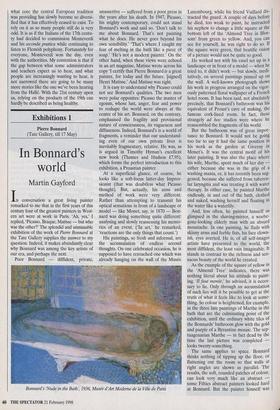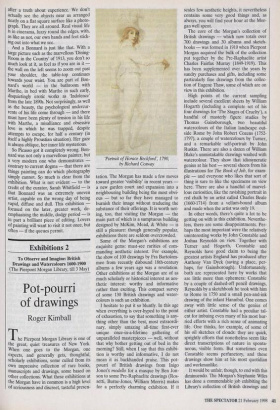Exhibitions 1
Pierre Bonnard (Tate Gallery, till 17 May)
In Bonnard's world
Martin Gayford
In conversation a great living painter remarked to me that in the first years of this century four of the greatest painters in West- ern art were at work in Paris. WI, yes,' I replied, Picasso, Braque, Matisse — but who was the other?' The splendid and unmissable exhibition of the work of Pierre Bonnard at the Tate Gallery supplies the answer to my question. Indeed, it makes abundantly clear why Bonnard was among the key artists of our era, and perhaps the next.
Poor Bonnard — diffident, private, unassertive — suffered from a poor press in the years after his death. In 1947, Picasso, his mighty contemporary, could not stand Bonnard's work and said so. 'Don't talk to me about Bonnard. That's not painting what he does. He never goes beyond his own sensibility.' That's where I caught my fear of melting in the bath like a piece of soap.' He's not a modern painter.' On the other hand, when these views were echoed in an art magazine, Matisse wrote across his copy 'I certify that Pierre Bonnard is a great painter, for today and the future. [signed] Henri Matisse.' And Matisse was right.
It is easy to understand why Picasso could not see Bonnard's qualities. The two men were polar opposites: Picasso the master of egoism, whose lust, anger, fear and power to reshape the world were always at the centre of his art. Bonnard, on the contrary, emphasised the fragility and provisional nature of consciousness, its vagueness and diffuseness. Indeed, Bonnard's is a world of fragments, a reminder that our understand- ing even of our own private lives is inevitably fragmentary, relative. He was, as is argued in Timothy Hyman's excellent new book (Thames and Hudson £7.95), which forms the perfect introduction to this exhibition, a Proustian painter.
At a superficial glance, of course, he looks like a soft-focus latter-day Impres- sionist (that was doubtless what Picasso thought). But, actually, his aims and method of work were very different. Rather than attempting to transmit his optical sensations in front of a landscape or model — like Monet, say, in 1870 — Bon- nard was doing something quite different: analysing and slowly reassessing his memo- ries of an event. (In art,' he remarked, `reactions are the only things that count.') His paintings, so fresh and informal, are the accumulation of endless second thoughts. On one celebrated occasion, he is supposed to have retouched one which was already hanging on the wall of the Musee Bonnard's 'Nude in the Bath, 1936, Musee d'Art Moderne de la Vile de Paris Luxembourg, while his friend Vuillard dis- tracted the guard. A couple of days before he died, too weak to paint, he instructed his nephew to change a little square at the bottom left of the 'Almond Tree in Blos- som' from green to yellow. And, you can see for yourself, he was right to do so. If the square were green, that beatific vision of a picture would not be quite so good.
He worked not with his easel set up in a landscape or in front of a model — when he tried to, it didn't work — but slowly, medi- tatively, on several paintings pinned up on the wall. A well-known photograph shows his work in progress arranged on the vigor- ously patterned floral wallpaper of a French hotel room. It has been said, not absolutely precisely, that Bonnard's bathroom was his equivalent of Proust's cave of making, the famous cork-lined room. In fact, these strangely ad hoc studios were where he reassembled the fragments of his world.
But the bathroom was of great impor- tance to Bonnard. It would not be going too far to say it had the same position in his work as the garden at Giverny in Monet's. It was the central motif of his later painting. It was also the place where his wife, Marthe, spent much of her day either because she was in the grip of a washing mania, or, it has recently been sug- gested, because she suffered from tubercu- lar laryngitis and was treating it with water therapy. In either case, he painted Marthe endlessly, in and out of the bath, clothed and naked, washing herself and floating in the water like a waterlily.
And, less often, he painted himself as glimpsed in the shaving-mirror, a woebe- gone-looking elderly man with an absurd moustache. In one painting, he flails with skinny arms and feeble fists, his face clown- ish, eyes averted. He is, of all self-images artists have presented to the world, the most diffident, the least vain imaginable. It stands in contrast to the richness and sen- suous beauty of the world he created.
As the example of the square of yellow in the 'Almond Tree' indicates, there was nothing literal about his attitude to paint- ing. 11 fact mentir,' he advised, it is neces- sary to lie. Only through an accumulation of such lies will it be possible to get at the truth of what it feels like to look at some- thing. So colour is heightened, for example, in the three late paintings of Marthe in the bath that are the culminating point of the exhibition, until the ordinary white tiles of the Bonnards' bathroom glow with the gold and purple of a Byzantine mosaic. The sep- tuagenarian Marthe — in fact dead by the time the last picture was completed looks twenty-something.
The same applies to space. Bonnard thinks nothing of tipping up the floor, or flattening out the room so that walls at right angles are shown as parallel. The results, the soft, rounded patches of colour, can look very much like an abstract some Fifties abstract painters looked hard at Bonnard. But the painter himself was after a truth about experience. We don't actually see the objects near us arranged neatly on a flat square surface like a photo- graph. They are all around. Real visual life is in cinerama, fuzzy round the edges, with, as like as not, our own hands and feet stick- ing out into what we see.
And a Bonnard is just like that. With a large picture such as the marvellous 'Dining- Room in the Country' of 1913, you don't so much look at it, as feel as if you are in it the wall on the left seems to zoom out past your shoulder, the table-top continues towards your waist. You are part of Bon- nard's world — in the bathroom with Marthe, in bed with Marthe in such early, disquietingly erotic works as 'Indolence' from the late 1890s. Not surprisingly, as well as the beauty, the psychological undercur- rents of his life come through — and there must have been plenty of tension in his life with Marthe, a misalliance and obsessive love in which he was trapped, despite attempts to escape, for half a century (in itself a highly Proustian situation). Her gaze is always oblique, her inner life mysterious.
So Picasso got it completely wrong. Bon- nard was not only a marvellous painter, but a very modem one who demonstrates contrary to current dogma — that there are things painting can do which photography simply cannot. Sp much is clear from the exhibition. What is not evident — to the credit of the curator, Sarah Whitfield — is that Bonnard was an extremely uneven artist, capable on the wrong day of being vapid, diffuse and dull. This exhibition focused on the later, greater work, de- emphasising the middle, dodgy period — is in part a brilliant piece of editing. Lovers of painting will want to visit it not once, but often — if the queues permit.



























































 Previous page
Previous page